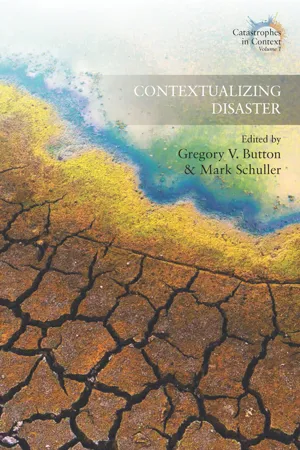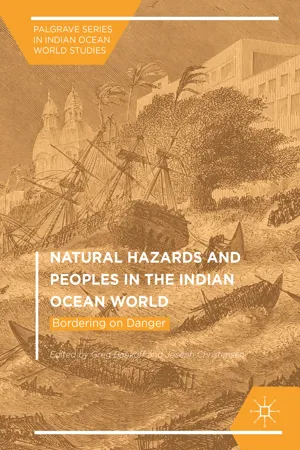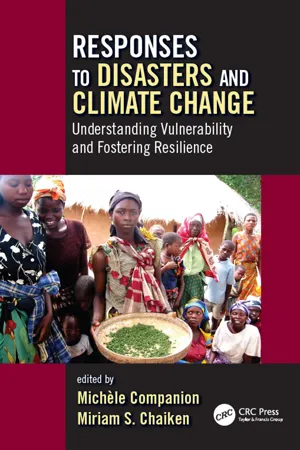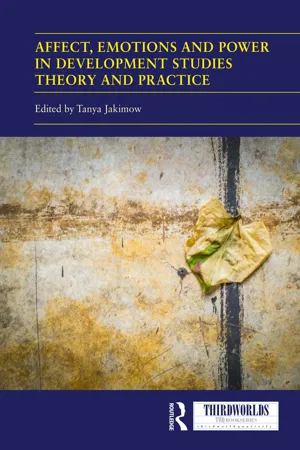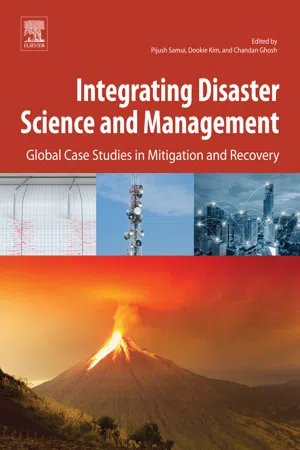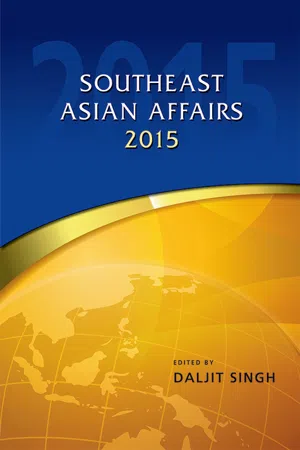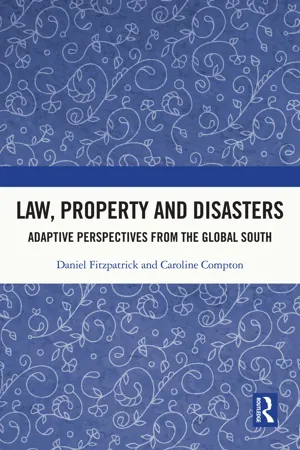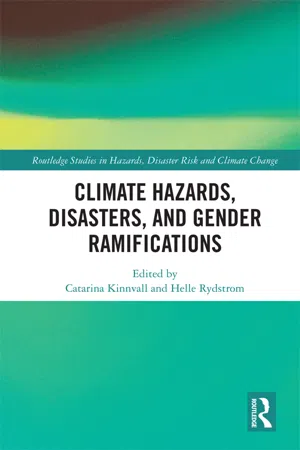Geography
Typhoon Haiyan
Typhoon Haiyan, also known as Yolanda, was one of the strongest tropical cyclones ever recorded. It struck the Philippines in November 2013, causing widespread devastation with its powerful winds and storm surges. The typhoon resulted in thousands of deaths and significant damage to infrastructure, making it one of the most destructive natural disasters in the country's history.
Written by Perlego with AI-assistance
Related key terms
1 of 5
10 Key excerpts on "Typhoon Haiyan"
- eBook - ePub
- Gregory V. Button, Mark Schuller, Gregory V. Button, Mark Schuller(Authors)
- 2016(Publication Date)
- Berghahn Books(Publisher)
CHAPTER 2
Whethering the Storm
The Twin Natures of Typhoons Haiyan and Yolanda
GREG BANKOFF and GEORGE EMMANUEL BORRINAGASuper Typhoon Haiyan, known in the Philippines as Typhoon Yolanda, started life as a tropical depression in the western North Pacific (WNP) somewhere southeast of Pohnpei on November 3, 2013. As it tracked in a west-northwesterly direction, it intensified into a tropical storm, then passed over the small island nation of Palau before developing into one of the strongest cyclones in world history as it struck the central Philippines. Making landfall near Guiuan on eastern Samar in the early morning of November 8 with maximum wind speeds around 300 kilometers per hour, the typhoon was accompanied by a storm surge with wave heights of between six and seven meters and rain that caused extensive flooding, even if it was “not very heavy in comparison to many other tropical cyclones making landfall in the Philippines in the past” (Neussner 2014, 17). The islands of Samar and Leyte were particularly hard hit with Tacloban City, the capital and seat of government of Region VIII, virtually wiped off the map: 60 percent of structures were destroyed and another 30 percent severely damaged. More than 6,000 people died, over 2 million people were left homeless, and perhaps as many as 14 million people were affected in some way. Damages amounted to as much as $13.6 billion (PHP 590 billion) with near-total losses to agricultural production in the eastern Visayas, particularly sugarcane, rice, and copra. The regional GDP is estimated to have been cut by at least 40 percent (Daniell et al. 2013, 1–3).About twenty-five tropical depressions reach storm intensity or higher each year over the warm waters of the WNP, mainly between April and December. In fact, the WNP accounts for about one-third of all such storms in the world (Elsner and Liu 2003; Japan Meteorological Agency n.d.). Tropical cyclones whose maximum wind speeds exceed 119 kilometers per hour are known as typhoons and are mainly referred to in the Philippines as bagyos - eBook - ePub
Natural Hazards and Peoples in the Indian Ocean World
Bordering on Danger
- Greg Bankoff, Joseph Christensen, Greg Bankoff, Joseph Christensen(Authors)
- 2016(Publication Date)
- Palgrave Macmillan(Publisher)
In this chapter, I elaborate briefly on the two types of cyclonic storms that affect the Philippine Archipelago annually and then give a description of the typhoon phenomenon: how it is formed, where it originates from and historical difficulties with forecasting the approach or trajectory of any given typhoon. I discuss problems associated with the seasonal patterns, increasing wind speeds and the successive nature of typhoons that are associated with the Philippines, before turning my attention to important analysis associated with the El Niño and La Niña phenomena. In conclusion, I discuss the impact of typhoons on agriculture and explore the suitability of various responses to the inevitable humanitarian crises and the dire associated costs as more such disasters will increasingly occur in this century.Throughout this discussion, I interweave the associated death, destruction, heartache and hunger wrought on the Visayan Islands by Super Typhoon Haiyan (named Yolanda in the Philippine Area of Responsibility, or PAR) on 8 November 2013. Haiyan is estimated to be the most ferocious typhoon ever to make landfall anywhere in the world. The storm packed winds of over 350 kilometres per hour (km/h) (190–195 mph), and with an accompanying storm surge, it centred on and flattened Tacloban city (see Map 5.1 ).2Haiyan also left a 600-km-wide swathe of destruction across the islands of Panay, Bohol and Leyte and substantially elevated the annual percentage of GDP spent on typhoon damage for 2013. The Philippines suffers an estimated $US1.6 billion in losses each year from the calamities,3but Haiyan’s ‘economic losses alone were valued at $15 billion.’4Map 5.1 Path of Super Typhoon Haiyan, November 2013Definition of a Typhoon
The Jesuit meteorologists of the early twentieth century made clear the exact meaning they gave to the term typhoon. Louis Froc S.J., in his Observatory Atlas of the Tracks of 620 Typhoons 1893 –1918 , clarified that the term ‘typhoon’ explained a dynamic–physical understanding of:all the depressions, or cyclones of oceanic origin, born more generally under the tropics, but not always so far, which as a rule advance from the open sea, towards the Asiatic coasts, or towards the long line of islands developed in a large arc, roughly circular, from Borneo and the Philippines to Japan, the Kurile and Aleutian Islands and Kamchatka. It is a class of phenomena entirely distinct from the group of the continental squalls or depressions, born on the land and progressing, in an opposite way, towards the Ocean.5 - eBook - ePub
Responses to Disasters and Climate Change
Understanding Vulnerability and Fostering Resilience
- Michele Companion, Miriam S. Chaiken(Authors)
- 2016(Publication Date)
- CRC Press(Publisher)
In the Philippines, roughly one third of the population depends on agriculture and fishing to make a living. Women make up a large proportion of Filipino fishers. However, as one of the most disaster-struck countries in the world (Relief Web 2014), with approximately 75% of the population vulnerable to natural hazards (Relief Web 2012), these resource-dependent communities are left in a constant state of repair. While coastal populations face increased vulnerability, disaster risk also reflects existing social divisions. This is particularly true of social vulnerabilities rooted in gender, class, race, ethnicity, culture, and age relationships. Women’s roles as primary household managers, as well as their dependence on natural resource-based livelihoods (e.g., fisheries and aquaculture), are viewed as especially vulnerable to hazardous events that put their families at risk (Cutter 1995).In November 2013, the Philippines experienced Typhoon Haiyan (Yolanda), one of the largest to make landfall. An estimated 14.1 million people were affected, and over 6000 deaths were recorded (Food and Agriculture Organization [FAO] 2014). The President declared a State of National Calamity for the Category 5 super typhoon (Relief Web 2014). Almost 94% of casualties in the hardest hit cities were caused by the storm surge (Deutsche Gesellschaft für Internationale Zusammenarbeit 2014). Mass displacement and overcrowded conditions raised risks to safety and wellbeing of vulnerable groups, in particular women. A lack of female police officers, scarcity of women-only spaces in evacuation centers, and disrupted maternal and reproductive health services made the challenge of reducing the risks to vulnerable groups even harder (Relief Web 2014). Fishing communities reported losing two-thirds of their fishing equipment (Relief Web 2014). Nearly 30% of fisher folk (Filipino term for fishermen/women) in Haiyan’s path were affected, resulting in 24,000 MT of fisheries stocks lost (Office of the Presidential Assistant for Rehabilitation and Recovery 2014) (Figure 15.1 ).One year later, the nation was hit again with Super Typhoon Hagupit (Ruby). It arrived in the Philippines on December 6, 2014, as a Category 2, with moderate to heavy rains. It weakened as it moved through the nation (Figure 15.2 - Tanya Jakimow(Author)
- 2023(Publication Date)
- Routledge(Publisher)
Dalisay and De Guzman 2016 ). Bodies, as was harrowingly discussed through our interviews and focus groups, were still being found months, even years, later.This article is in no way meant to provide a representative account of the millions of people affected by the typhoon. It does, however, begin to respond to some questions: What are some of the ways that extreme weather events are known and understood by those who experience them? And how do people, communities and more-than-human publics respond? While we hear much from government and NGOs, and see media footage of extreme disasters as and soon after they occur, rarely are the long-term effects or actual experiences and understandings of those affected given consideration, particularly if those affected live in the Global South (Whittle et al. 2012 ).We have drawn upon the accounts of activists and community organisers involved in POs and NGOs affiliated with the MASIPAG network. This is a particular group of people who have spent decades honing their skills in analysis, critical thinking and organising. As such, they are uniquely situated to speak to resistance and change in understanding and experiencing climate. These are emotional accounts, and emotions sit at the centre of the ways climate change is understood and responded to – to climate change’s knowings and doings. There are layers of trauma and grief, nourishment and wonder, tenacity and care.We have elaborated the concept of knowledge spaces to rethink and deepen attention to emotional and affective dimensions of knowing and doing, and we have done so with attention to the topologies of these spaces. Knowledge spaces point to emotions, peoples, places and technologies as not only points where knowledge is contextualised, but also where it is produced, reproduced and contested. Knowledge spaces are rich, multitemporal and multiscalar, and – importantly – both dynamic and persistent. Consideration of these spaces as topologies, in particular, draws attention to the multiplicity of potential relations that comprise a space and to the processes through which relations are challenged and shaped. What we know and how we experience climate come about through dynamic intra-actions. These are topologies of weather and climate that are both deeply emergent with and as place, emerging and creating the detailed realities of where and how we are, in ways interconnected with others.- Carolina G. Hernandez, Eun Mee Kim, Yoichi Mine, Ren Xiao, Carolina G. Hernandez, Eun Mee Kim, Yoichi Mine, Ren Xiao(Authors)
- 2018(Publication Date)
- Palgrave Macmillan(Publisher)
© The Author(s) 2019Begin AbstractHuman Security and Cross-Border Cooperation in East Asia Security, Development and Human Rights in East Asia https://doi.org/10.1007/978-3-319-95240-6_7Carolina G. Hernandez ,Eun Mee Kim ,Yoichi Mine andRen Xiao (eds.)7. The Haiyan Crisis: Empowering the Local, Engaging the Global
End AbstractPerlita M. Frago-Marasigan1(1) Department of Political Science, University of the Philippines, Quezon City, PhilippinesPerlita M. Frago-MarasiganIntroduction
At dawn on November 8, 2013, the Philippines became the target of a typhoon that was described by scientists as ‘one of the most powerful typhoons to have made landfall in recorded history’ (Lagmay et al. 2015 ). Assessed as a Category 5 super typhoon1by the Joint Typhoon Warning Center (JWTC), Haiyan , locally known as Yolanda, pillaged mostly the Eastern Visayan provinces located at the central part of the Philippines. Based on the official report of the country’s National Disaster Risk Reduction Management Council (NDRRMC) (2014 ), the typhoon claimed 6,300 lives, left 28,689 injured, displaced 4.1 million and damaged property amounting to 90 billion pesos (USD1.788 billion).2And these figures could be underestimated. This damage brought to light human security issues that tested the capacity of the Philippine government , both at the local and at the national levels, to address these problems and prompted the international community to respond accordingly. What complicates this case further are the partisanship issues that colored and compounded what could have been just a humanitarian case for disaster relief and aid . The perceived slow and inadequate disaster response by the Philippine government in the aftermath of the crisis, raises the need to examine sovereignty issues, as well as issues of coordination and empowerment. On the other hand, the Policy Department of the European Parliament notes that even though the Philippines had been criticized for its response to Haiyan , ‘the country is considered relatively well prepared’ when compared to Myanmar , given the higher death toll in the recent smaller Cyclone Nargis (Armanovica 2013- eBook - ePub
Integrating Disaster Science and Management
Global Case Studies in Mitigation and Recovery
- Pijush Samui, Dookie Kim, Chandan Ghosh(Authors)
- 2018(Publication Date)
- Elsevier(Publisher)
Haiyan was an exceptional storm; it brought precipitation in some places of up to 615 mm between the 3rd and the 12th of November, had an air pressure at its center of only 895 mbar, generated wind gusts of up to 375 km/h, and was one of the strongest typhoons to ever make a landfall in the entire Western North Pacific (Primavera et al., 2016 ; Takagi and Esteban, 2016 ; Takagi et al., 2015). When Haiyan reached Concepcion, Iloilo, on the island of Panay, it still had sustained wind speeds of 215 km/h, with gusts up to 250 km/h, and this was its fifth landfall (National Disaster Risk Reduction Management Council, 2014)! Dr. Wei Mei, a climate scientist at the Scripps Institution of Oceanography, in La Jolla, CA, stated that he was “shocked” by the strength of Haiyan (Personal Communication, November 4, 2015). Perhaps the most remarkable aspect of Haiyan was its storm surge of 7.4 m, which inundated 98 km 2 of the island of Leyte and 93 km 2 of the island of Samar (Cardenas et al., 2015). Lander et al. (2014, p. S114) described the storm surge as having “nearly the same force and rapidity as a destructive tsunami.” Not only was Haiyan a powerful storm, it was also believed to be the fastest storm on record and it was traveling westward at a speed of 41 km/h when it made a landfall (Takagi and Esteban, 2016). While meteorologists may have wondered in amazement at the sheer power of Haiyan, its consequences for the people of the Philippines were anything but wonderful. Eight of the 17 regions of the Philippines were affected by Haiyan and it generated 6245 deaths, 28,626 injuries, and caused 1039 people to be reportedly missing, with much of this damage occurring when the City of Tacloban (Box 24.1) was essentially destroyed (Takagi and Esteban, 2016). The storm caused between US $12 and US$ 15 billion worth of damages and resulted in the destruction of 1 million homes (Primavera et al., 2016) - eBook - PDF
- Daljit Singh(Author)
- 2015(Publication Date)
- ISEAS Publishing(Publisher)
Southeast Asian Affairs 2015 L ORRAINE C ARLOS S ALAZAR is a Knowledge Expert with a global management consulting firm based in Singapore. She was a Visiting Fellow at the Institute of Southeast Asian Studies (ISEAS), Singapore from 2005 to 2007. TYPHOON YOLANDA The Politics of Disaster Response and Management Lorraine Carlos Salazar Introduction On 8 November 2013, typhoon Yolanda (internationally referred to as Haiyan), the strongest recorded typhoon ever to make landfall hit central Philippines, with wind speeds of more than 300 km/hour and storm surges of over four metres. Yolanda’s impact was massive. It passed through 171 cities and municipalities in fourteen provinces in the country leading to an estimated 6,300 deaths, over a thousand people missing, around 1.5 million families (around 7.5 million individuals) displaced, and in all affecting 3.4 million families (about 16 million people) and damaging or destroying a million homes. 1 Experts opine that in some ways the impact of Yolanda was greater than the Haiti earthquake in terms of shelter damage (affecting about 475,000 people in 95,000 households) or the 2004 tsunami in terms of total number of people affected (about 2.3 million). 2 Yolanda’s total economic impact, estimated to reach US$10 billion in damages, was considered one of the top two most destructive disasters in the world during 2013. 3 The enormity of the disaster overwhelmed the administration of President Benigno Aquino whose response during the first few days of the crisis was widely criticized. The local governments of most of the affected areas, particularly Tacloban City, which suffered the most devastation, were caught 278 Lorraine Carlos Salazar unaware and took some time to get back on their feet and start organizing relief response. Meanwhile, haunting images broadcast internationally by the global media galvanized an unprecedented international response for relief and aid. - eBook - ePub
- (Author)
- 2014(Publication Date)
- Asian Development Bank(Publisher)
& AIN THE EYE OF THE STORM
PHOTOS: GETTY (SATELLITE IMAGE OF Typhoon Haiyan), ASSOCIATED PRESS (AQUINO)AN INTERVIEW WITH PHILIPPINES PRESIDENT BENIGNO AQUINO III
R arely the focus of global attention, the Philippines grabbed world headlines last November when Typhoon Haiyan smashed through its central region. As a history buff, President Benigno S. Aquino III must have hoped for a different story line. Typhoon Haiyan, the strongest tropical storm to make landfall in recorded history, turned the world’s gaze toward this sprawling archipelago of 7,000 islands.Suddenly this relatively new leader was, quite literally, in the eye of the storm.His family history might have fortified him for the task. His father, after whom he was named, was an opposition leader assassinated on his return from exile in 1983. His mother, Corazon Aquino, was swept to the presidency by the “People Power Revolution” of 1986 and led the country for 6 years. Aquino was shot five times—one of the bullets remains in his neck to this day—during a 1987 coup attempt against his mother’s rule.Unbowed, Aquino chose to go into politics after a stint working in the private sector. He was elected to the House of Representatives in 1998, where he became Deputy Speaker and served until 2007. He joined the Senate in the same year. In 2010, he won the presidency, and vowed to serve rather than rule the country’s nearly 100 million people.In conversation with Development Asia , President Aquino explains Typhoon Haiyan’s impact, his concerns about climate change, and outlines his vision of a resilient future for all Filipinos.DEVELOPMENT ASIA: How has Typhoon Haiyan (known in the Philippines as Yolanda) changed your view, if at all, of natural disasters and how to respond to them? BENIGNO AQUINO III - eBook - ePub
Law, Property and Disasters
Adaptive Perspectives from the Global South
- Daniel Fitzpatrick, Caroline Compton(Authors)
- 2021(Publication Date)
- Routledge(Publisher)
Introduction. In Michael D Gordin, Helen Tilley & Gyan Prakash (eds), Utopia/Dystopia: Conditions of Historical Possibility 293 (Princeton University Press, 2010).7 Scott, Seeing Like a State, supra n 5, 193–261.8 See Renato Constantino, A History of the Philippines: From the Spanish Colonization to the Second World War 58–59 (New York: Monthly Review Press, 1975).9 See generally P McAuslan, Bringing the Law Back In: Essays in Land, Law and Development (Routledge, 2003).10 See further Véronique M Morin, Mokbul Morshed Ahmad & Pennung Warnitchai, Vulnerability to Typhoon Hazards in the Coastal Informal Settlements of Metro Manila, the Philippines, 40 Disasters 693 (2016).The case study is Typhoon Haiyan, which hit the central Philippines in 2013 as one of the strongest storms ever to make landfall. To reduce the risk of future super typhoons, the recovery plan proposed coastal “no-dwelling zones” and relocation of over 200,000 households from coastal areas. Most of those affected lived close to the sea in urban informal settlements. Others were fisherfolk living on land classified as public foreshore land. Because many were unable to access transitional shelter and did not receive timely relocation assistance, most households returned to their original lands notwithstanding their classification as no-build zones.11 Their housing is now vulnerable to future typhoons, as they were denied access to in situ - Catarina Kinnvall, Helle Rydstrom, Catarina Kinnvall, Helle Rydstrom(Authors)
- 2019(Publication Date)
- Routledge(Publisher)
In noting the importance of cross-societal and cross-cultural differences, disaster researchers will be able to see things that “we do not see at present, being somewhat a prisoner of our own culture” (Quarantelli, Lagadec, and Boin 2007, 39). Along this line Doug Henry contends that an ‘expanded horizon’ is necessary for examining the complex relationships between humans, culture and their environment; and issues such as vulnerability and perceived risk, individual and social responses and coping strategies (2007, 111). Such approaches go beyond “a habitual way of looking at disaster phenomena” (Quarantelli 1982, 453), and inspires researchers to adopt a more “nuanced, international, and comparative perspective” (Enarson, Fothergill, and Peek 2007). Research has been conducted on relief efforts and recovery processes in the Global North (Peacock, Morrow, and Gladwin 1997), as well as in developing countries such as Bangladesh (Haque and Zaman 1993) and Peru (Oliver-Smith 1994). Following fieldwork in Honduras and the United States, Anthony Oliver-Smith (2009), for example, presents similarities in the ways political economic behaviours and policies of governing elites are linked with common people’s experiences of disasters following the 1992 Hurricane Andrew and the 1998 Hurricane Mitch.Haiyan survivors en masse have demanded immediate relief and rehabilitation and have criticised the central government for alleged ‘criminal negligence’ months after the calamity (People Surge 2014). Oliver-Smith points out that while disasters diminish the agency of people, turning them into passive victims, people can reclaim agency and restore a sense of meaning and direction through the reconstruction process (2009, 26). As Sherry Ortner (2016, 60) reminds us, “it is important to look at the caring and ethical dimensions of human life, for what is the point of opposing neoliberalism if we cannot imagine better ways of living and better futures? How can we be both realistic about the ugly realities of the world today and hopeful about the possibilities of changing them?”.The empirical context
The Philippines, a densely populated country of 97 million people, is one of the most climate disaster-prone countries in the world. It experiences an average of 20 typhoons per year (Oxfam 2013), due to its location along the typhoon belt in the Western Pacific. In addition, the country sits astride the earth’s ‘Ring of Fire’, being exposed to periodic volcanic eruptions and earthquakes.From geographical and meteorological perspectives, Tacloban is a danger spot in itself because it is below sea level. In the north and the west, the city is bound by mountains, which often means landslides, especially when wind and rain are ferocious as during Haiyan (BPI Foundation and World Wide Fund for Nature 2014). Moreover, the V-shaped geography of the area serves to funnel the mass of water, with the shallow depths of San Pedro Bay amplifying the surge heights (Esteban et al. 2015). Tacloban is a migratory city of Eastern Visayas, with a population of about 200,000. Despite the fact that the city’s coastal districts are below sea level, many major buildings were built right by the sea including the city hall, schools, colleges and hospitals. Also, there is a big gap between the resident- and the commuter-adjusted population and commuters can nearly quadruple the local population during the daytime. This makes Tacloban less homogenous than its neighbour municipality of Palo. There are, furthermore, a rather large number of migrants working in informal economic activities in Tacloban.
Index pages curate the most relevant extracts from our library of academic textbooks. They’ve been created using an in-house natural language model (NLM), each adding context and meaning to key research topics.
